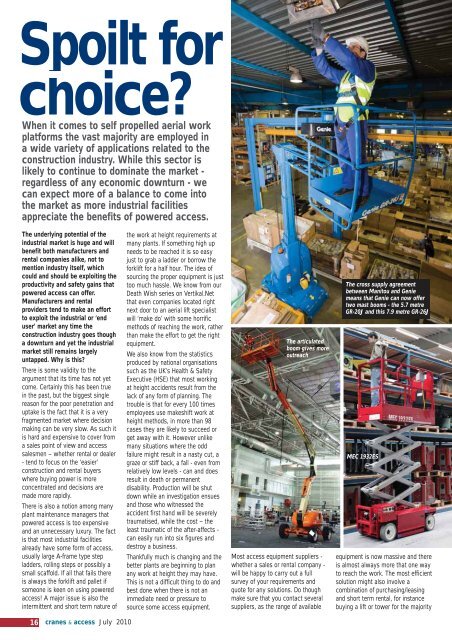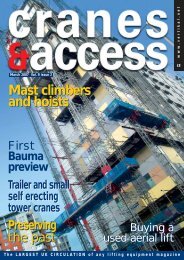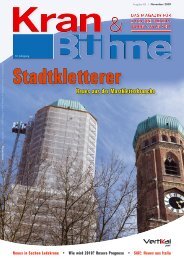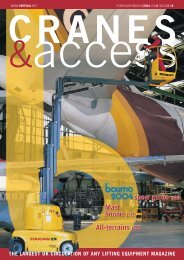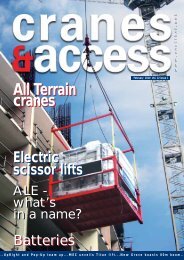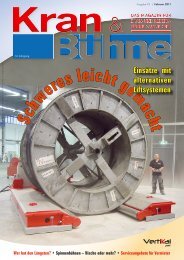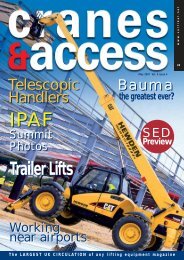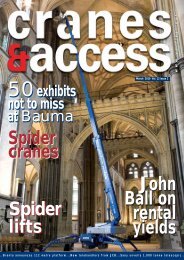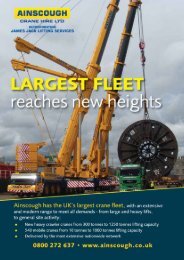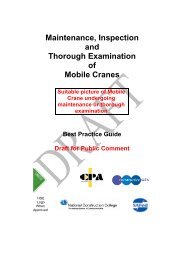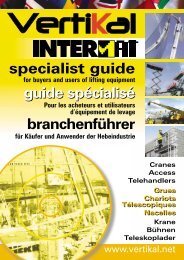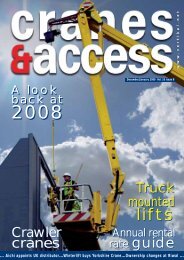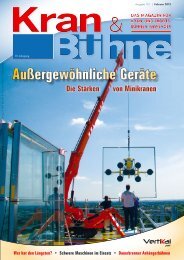Selling
Selling
Selling
Create successful ePaper yourself
Turn your PDF publications into a flip-book with our unique Google optimized e-Paper software.
Spoilt for<br />
choice?<br />
When it comes to self propelled aerial work<br />
platforms the vast majority are employed in<br />
a wide variety of applications related to the<br />
construction industry. While this sector is<br />
likely to continue to dominate the market -<br />
regardless of any economic downturn - we<br />
can expect more of a balance to come into<br />
the market as more industrial facilities<br />
appreciate the benefits of powered access.<br />
The underlying potential of the<br />
industrial market is huge and will<br />
benefit both manufacturers and<br />
rental companies alike, not to<br />
mention industry itself, which<br />
could and should be exploiting the<br />
productivity and safety gains that<br />
powered access can offer.<br />
Manufacturers and rental<br />
providers tend to make an effort<br />
to exploit the industrial or ‘end<br />
user’ market any time the<br />
construction industry goes though<br />
a downturn and yet the industrial<br />
market still remains largely<br />
untapped. Why is this?<br />
There is some validity to the<br />
argument that its time has not yet<br />
come. Certainly this has been true<br />
in the past, but the biggest single<br />
reason for the poor penetration and<br />
uptake is the fact that it is a very<br />
fragmented market where decision<br />
making can be very slow. As such it<br />
is hard and expensive to cover from<br />
a sales point of view and access<br />
salesmen – whether rental or dealer<br />
- tend to focus on the ‘easier’<br />
construction and rental buyers<br />
where buying power is more<br />
concentrated and decisions are<br />
made more rapidly.<br />
There is also a notion among many<br />
plant maintenance managers that<br />
powered access is too expensive<br />
and an unnecessary luxury. The fact<br />
is that most industrial facilities<br />
already have some form of access,<br />
usually large A-frame type step<br />
ladders, rolling steps or possibly a<br />
small scaffold. If all that fails there<br />
is always the forklift and pallet if<br />
someone is keen on using powered<br />
access! A major issue is also the<br />
intermittent and short term nature of<br />
16 cranes & access July 2010<br />
the work at height requirements at<br />
many plants. If something high up<br />
needs to be reached it is so easy<br />
just to grab a ladder or borrow the<br />
forklift for a half hour. The idea of<br />
sourcing the proper equipment is just<br />
too much hassle. We know from our<br />
Death Wish series on Vertikal.Net<br />
that even companies located right<br />
next door to an aerial lift specialist<br />
will ‘make do’ with some horrific<br />
methods of reaching the work, rather<br />
than make the effort to get the right<br />
equipment.<br />
We also know from the statistics<br />
produced by national organisations<br />
such as the UK’s Health & Safety<br />
Executive (HSE) that most working<br />
at height accidents result from the<br />
lack of any form of planning. The<br />
trouble is that for every 100 times<br />
employees use makeshift work at<br />
height methods, in more than 98<br />
cases they are likely to succeed or<br />
get away with it. However unlike<br />
many situations where the odd<br />
failure might result in a nasty cut, a<br />
graze or stiff back, a fall - even from<br />
relatively low levels - can and does<br />
result in death or permanent<br />
disability. Production will be shut<br />
down while an investigation ensues<br />
and those who witnessed the<br />
accident first hand will be severely<br />
traumatised, while the cost – the<br />
least traumatic of the after-affects -<br />
can easily run into six figures and<br />
destroy a business.<br />
Thankfully much is changing and the<br />
better plants are beginning to plan<br />
any work at height they may have.<br />
This is not a difficult thing to do and<br />
best done when there is not an<br />
immediate need or pressure to<br />
source some access equipment.<br />
The articulated<br />
boom gives more<br />
outreach<br />
Most access equipment suppliers -<br />
whether a sales or rental company -<br />
will be happy to carry out a full<br />
survey of your requirements and<br />
quote for any solutions. Do though<br />
make sure that you contact several<br />
suppliers, as the range of available<br />
The cross supply agreement<br />
between Manitou and Genie<br />
means that Genie can now offer<br />
two mast booms - the 5.7 metre<br />
GR-20J and this 7.9 metre GR-26J<br />
MEC 1932ES<br />
equipment is now massive and there<br />
is almost always more that one way<br />
to reach the work. The most efficient<br />
solution might also involve a<br />
combination of purchasing/leasing<br />
and short term rental, for instance<br />
buying a lift or tower for the majority


